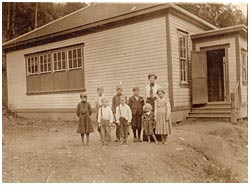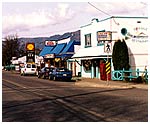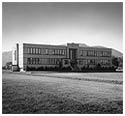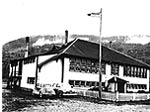
Two events conspired to bring about the rural community we know as Yarrow. In 1910, the British Columbia Electric Railway [BCER] completed construction of a railway line that followed the base of Vedder Mountain, along the shores of Sumas Lake. The construction of the BCER meant improved transportation and communications, and an alternative to steam powered riverboat travel along the Fraser River. With the construction of the line the BCER established a station stop, that was named Yarrow. There are two versions of how Yarrow got its name. The first is that is was named after the Yarrow plant, which has "fine fern-like leaves and small white flowers. Sometimes referred to as a weed, it grows profusely in this area." The other version posits that "when the railway was being constructed, the builder had trouble with one landowner across whose property the line had to run. When the time came to name the station, it was deemed only fitting that the name be "Yarrow" after the bitterest herb growing in the community." Coutts, Cecil., Cancelled with Pride.
The second major event was the draining of Sumas Lake, completed in the mid-1920s. This large scale dyking and drainage project resulted in the former foreshore and lake bed areas being divided into agricultural lands. It is within this context that Yarrow grew and developed as a community.
The history of schools in Yarrow has its roots in the logging and farming community that grew and developed on Majuba Hill. The first classes for school age children on Majuba Hill were held in the Chadsey family home, and as the community grew they petitioned the Chilliwack School Board to build a proper school. The School Board consented to supply the lumber, if the people of the community would volunteer their labour to build the school. As a result of the petition a one-room school was built on the Chadsey property, with fifteen children listed in the earliest register. The school register for 1914 lists William Robertson as the teacher of 15 students with familiar local family names, Chadsey, Dickie, Larson, Maitland, Martin, and Simmons.
Despite the growth of the community, and the petitions for a school, the first school in Yarrow proper did not come until the summer of 1928. The year 1928 is a watershed for the community of Yarrow, because it saw an influx of Mennonite families arriving from the prairies and points beyond. These families found temporary shelter in a vacant house on Majuba Hill, with the children attending the Majuba Hill School. The one room school was filled to capacity, and by the summer of 1928 a one-room school was built in the eastern corner of what is today Yarrow Park. Miss Currie, the teacher at Majuba Hill, was transferred to take charge of the new school in Yarrow. On opening day, September 13, 1928, the community in Yarrow consisted of 21 families, with a school enrollment of 29 students.
A major change for education in Yarrow occurred in 1952, with the acquisition of newly built and recently vacated Sharon Mennonite Collegiate Institute on Wilson Road North. After busing junior high aged students to Chilliwack for many years, the decision was made to purchase the former Sharon Institute for a modest $60,000. This new Yarrow Junior High School operated for 12 years, from 1952 to 1964, and in 1964 became Yarrow Elementary.
The first Mennonites immigrated into Yarrow in 1928, with the Bargan and Sawatzky families taking up residence on land purchased from local land developer Mr. Chauncey E. Eckert. During these years Mennonite farmers experimented with a variety of crops, including sugar beets, beans, lettuce, asparagus, cabbage and rhubarb. During the 1930s and 1940s many Mennonites relied on extra income provided through work in local hop yards.
In 1936, the raspberry growers in the Yarrow area formed the Yarrow Growers Association, with William Schellenberg as the first president. One year later the Co-op began selling consumer goods at wholesale prices and became known as the Yarrow Growers Co-operative Association. The drop in markets and increased competition following the Second World War resulted in the liquidation of the Co-op in the spring of 1949.
The church was always an important part of the social and moral fabric of the community. The first Mennonite Church service took place in April of 1928. The Mennonites continued to meet in private homes until 1930, when the Mennonite Brethren built their first church.
During the early years an unofficial local government formed in Yarrow to cope with problems, such as providing roads, water supply, and heading off emergencies such as fire and local flooding. This local body took a more official form in 1944, when the Yarrow Waterworks District was granted a charter and soon became the unofficial governing body of the Yarrow community. Its original mandate, to provide drinking water from a source on Vedder Mountain, was expanded to include irrigation, sidewalk construction, street lights, and a volunteer fire department.

Class photo of Majuba Hill School, ca. 1905, with Miss Pearl Crankshaw teacher. P1522.

Yarrow - Modern,2000

View of Yarrow Elementary / Junior High on North Wilson Road as it appeared ca. 1961. P3875.

Aerial view of Yarrow and surrounding area. P4751.

View of four room Yarrow Elementary on Yarrow Central, 1949. P1524.